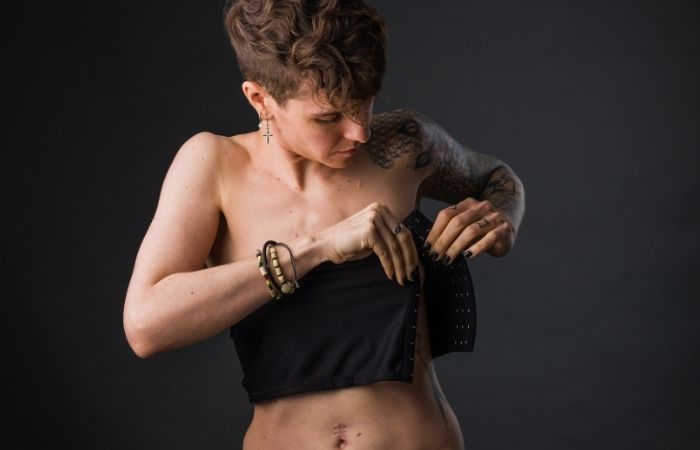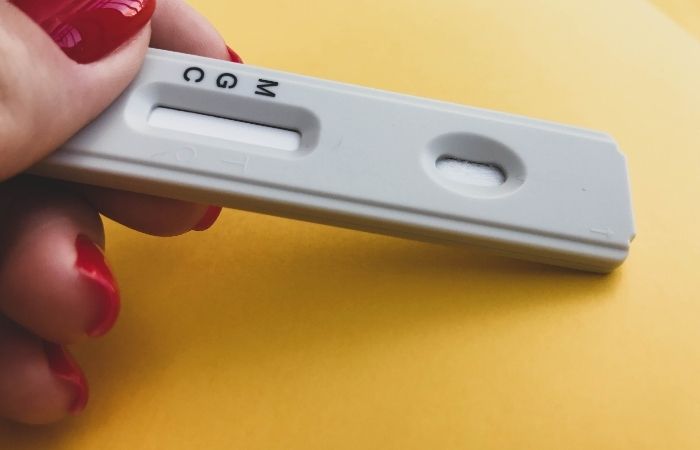Understanding Nonbinary Bodies and STD Symptoms
No two bodies are identical, and hormone therapies, surgeries, or binding practices can change how infections present. For example, a transmasculine person on testosterone may notice skin changes that mask a typical chlamydia discharge, while a nonbinary person with a vagina might mistake binding irritation for a yeast infection. Recognizing your baseline is key: pay attention when something feels “off” compared to your usual experience.
- Hormones & Mucous Membranes: Testosterone can thin vaginal tissues, increasing microabrasions and infection risk (Reisner et al., 2016).
- Binding & Rashes: Chest binding traps moisture and friction; rashes on your torso or under your binder may mirror genital rash symptoms.
- Post-Op Sensations: Surgeries like metoidioplasty or vaginoplasty alter nerve pathways, what feels “normal” post-op isn’t always a sign of infection.

People are also reading: The STD That Ate My Organs: Untreated Infections Gone Horribly Wrong
Common Symptoms and What They Might Mean
STD symptoms don’t read gender labels. Below are some presentations you might notice, along with infections to consider:
- Genital Rash: Red, itchy patches or bumps. Could be herpes, syphilis, or HPV-related warts.
- Unusual Discharge: Thick, colored, or foul-smelling fluid from genitals. Often chlamydia or gonorrhea; a nonbinary-friendly Gonorrhea Test Kit can clarify.
- Painful Urination: Burning or stinging when peeing. Could signal urethritis from chlamydia, gonorrhea, or a UTI, don’t ignore urinary pain in nonbinary bodies.
- Lower Abdominal Pain: Dull cramps or sharp twinges. Potential pelvic inflammatory disease (PID) following untreated infections; hormone-related tissue changes can worsen discomfort.
- Unexplained Fever or Fatigue: General malaise can accompany acute HIV or syphilis, consider an HIV Test Kit and timing guidance.
Early detection stops complications. If you tick any bullet above, grab an at-home kit, no clinic dead-naming required.
Barriers in Clinic-Based Testing
- Deadname & Records Mismatch: Intake forms demand legal names and birth sex, triggering dysphoria and making it hard to focus on symptoms.
- Provider Assumptions: “You don’t identify as a woman, you don’t need Pap smears,” or “You have a penis; you can’t get vaginal infections.” These myths delay HPV, gonorrhea, and chlamydia screening.
- Lack of Trans Training: Staff unfamiliar with binding or affirming surgeries may mistake infection signs for routine post-op healing or binder rash.
- Travel & Wait Times: Trans‐competent clinics cluster in major cities. Rural or global readers face months‐long waits, unpaid time off, or unsafe transit just to test.
- Stigma & Safety: Fear of invasive gender-history interviews or outing stops many from even booking an appointment.
The Rise of At-Home Testing Solutions
When clinic access feels like scaling a wall, at-home kits become your secret weapon. No forms, no waiting rooms, just clear instructions, discreet packaging, and results in days.
- Total Confidentiality: Arrive in plain, unmarked boxes. Your testing stays between you and your mailbox.
- Global Reach: STD Rapid Test Kits ships worldwide, bridging gaps where trans-friendly clinics don’t exist.
- Inclusive Instructions: Language like “genitals” and “partners,” photo guides reflecting diverse bodies, and zero dead-name prompts.
- Comprehensive Panels: Test for chlamydia, gonorrhea, trichomoniasis, and more at once, covering overlapping symptom profiles.
- Supportive Follow-Up: Queer-competent telehealth and text support to guide you through results and next steps.
Check Your STD Status in Minutes
Test at Home with Remedium6-in-1 STD Test Kit

 For Men & Women
For Men & Women Results in Minutes
Results in Minutes No Lab Needed
No Lab Needed Private & Discreet
Private & DiscreetOrder Now $119.00 $294.00
For all 6 tests
Choosing the Right At-Home Kit
Not all at-home kits are created equal. To make sure you’re testing right, check for:
- Regulatory Approval: FDA-cleared or CE-marked for high accuracy standards.
- Sample Flexibility: Urine, vaginal, or rectal swabs, pick what matches your anatomy and symptoms.
- Trans-Affirming Packaging: Pronoun-neutral labels, they/them language, and no dead-name prompts.
- Clear Result Timelines: 2–5 day return windows and easy-to-read digital reports.
- Referral Resources: Built-in links to queer-friendly clinics or telehealth for treatment after a positive result.
Testing Windows and Frequency
Timing is everything. Different STDs require different “window periods”, the time between exposure and detectable infection. Testing too early can produce a false negative, leaving you falsely reassured. Below is a rough guide for at-home kits:
- Chlamydia & Gonorrhea: Detectable 2–5 days post-exposure. Test again at 1 month if you had high-risk contact.
- Trichomoniasis: Usually detectable within 5–7 days. If you had symptoms before that, wait at least one week.
- Syphilis: Antibodies develop around 3–6 weeks. If you suspect syphilis, plan for two tests: one at 4 weeks and another at 12 weeks.
- HIV: Modern RNA or antigen/antibody combo tests pick up infection 10–14 days post-exposure. If your HIV Test Kit is antibody-only, wait 4 weeks for reliable results.
- HPV: No definitive window, test via Pap smear or HPV DNA after persistent symptoms like warts.
For ongoing risks, new partners, missed PrEP doses, or shared gear, consider quarterly screening. A routine schedule helps catch asymptomatic infections common in nonbinary bodies, where symptoms might be subtle or misattributed to binding or hormone changes.
Interpreting Your At-Home Kit Results
https://www.stdrapidtestkits.com/Getting results is both relief and anxiety. Here’s how to read your digital report:
- Negative Results: Means no infection detected at that time, but only for STDs tested. Continue routine checks if you remain at risk.
- Positive Results: Indicates the presence of genetic material or antibodies. Confirm with a healthcare provider or telehealth service familiar with trans/nonbinary care.
- Inconclusive/Invalid: Often due to insufficient sample. Kits usually include a second-fail safety net, submit a new sample within 14 days.
- Next Steps Link: Many kits from STD Rapid Test Kits provide built-in referrals to queer-competent telehealth for treatment prescriptions and counseling.
Keep your report on file. If you switch providers or apply for insurance coverage, having documented, time-stamped results in your own name (no dead-naming) helps maintain continuity of care.

People are also reading: Will They Swab There? Inside the Awkward Truth About STD Testing
What to Do After a Positive Test
First, take a moment. A positive result isn’t a moral failing, it’s a medical finding. Here’s your game plan:
- Confirm & Treat: Use the kit’s telehealth link or find a local queer-affirming clinic. Many antibiotics and antivirals are effective if started early.
- Notify Partners: Confidential partner notification services let you inform past partners without revealing your identity.
- Re-Test: Follow-up testing at 3 months ensures treatment worked and checks for reinfection.
- Mental Health Check: A positive STD can trigger shame or anxiety. Reach out to LGBTQ+ support hotlines or therapists experienced in trans and nonbinary care.
Prevention Strategies Tailored for Nonbinary & Trans Folks
Prevention isn’t one-size-fits-all, especially when your body and identity fall outside binary norms. These tactics help you reduce risk on your own terms:
- Barrier Methods for All Anatomy: Use internal condoms (formerly femidoms) for vaginas, external condoms for penises, and dams (cut-up latex sheets) for oral and front-hole play.
- PrEP & PEP Access: Pre-exposure prophylaxis (PrEP) can reduce HIV risk by over 99% when taken daily. Many telehealth providers now offer trans-competent PrEP consultations, no in-person appointment needed.
- Clean Gear Practices: If you use packers, binders, or prosthetics during sex, sanitize them according to manufacturer guidelines and avoid sharing without proper cleaning.
- Regular Check-Ins: Combine at-home STD panels with quarterly telehealth visits. Keeping your own health timeline, rather than waiting on clinic recalls, puts you in control.
- Vaccinations: HPV vaccination is recommended up to age 45; hepatitis A and B vaccines protect against blood-borne and bodily-fluid transmissions.
Talking to Partners About Testing and Boundaries
Conversations about sexual health can be awkward, especially if your partner isn’t used to gender-diverse language. Here’s how to keep it clear and affirming:
- Use “I” Statements: “I got my results from an at-home STD Rapid Test Kits panel and wanted to share mine and ask about yours.”
- Normalize Testing: Frame it as standard self-care, “I test quarterly because I value our health and honesty.” This reduces stigma and centers mutual respect.
- Set Clear Boundaries: Talk about what you’re comfortable with anatomically and emotionally. For example: “I’m only up for front-hole play if we both test negative for chlamydia and gonorrhea.”
- Share Resources: Link partners to trans-inclusive testing sites or offer to send them an at-home kit, “Here’s how easy it was for me to order confidentially.”
Check Your STD Status in Minutes
Test at Home with Remedium8-in-1 STD Test Kit

 For Men & Women
For Men & Women Results in Minutes
Results in Minutes No Lab Needed
No Lab Needed Private & Discreet
Private & DiscreetOrder Now $149.00 $392.00
For all 8 tests
Mental Health and Community Support
An STD scare can trigger anxiety, dysphoria, or shame, especially when compounded by past healthcare trauma. You’re not alone:
- LGBTQ+ Peer Networks: Online forums (e.g., TransPulse, Reddit’s r/asktransgender) and local support groups provide judgment-free spaces to share experiences and coping strategies.
- Queer-Competent Therapists: Services like QueerSpace and Pride Counseling offer sliding-scale virtual therapy with clinicians trained in trans and nonbinary care.
- Mind-Body Practices: Breathwork, grounding exercises, and body-affirming yoga can soothe the stress response after testing or a positive result.
- Stigma Reduction: Sharing anonymous stories, like in “Our Bodies, Our Tests” on Autostraddle, helps normalize testing and dismantle shame around trans and nonbinary sexual health.
FAQ
1. What symptoms should prompt nonbinary people to get tested for STDs?
If you notice genital rash, unusual discharge, pain during urination, or unexplained abdominal pain, it’s time to test. Even mild symptoms can mask serious infections. Trust your instincts, testing early helps you get treatment faster.
2. How accurate are at-home STD test kits for trans bodies?
Most FDA-cleared or CE-marked kits boast over 95% sensitivity and specificity for chlamydia and gonorrhea. Accuracy holds regardless of gender identity, as long as you follow sample instructions. Always confirm positive results with a healthcare provider.
3. Can hormone therapy affect STD test results?
Hormones don’t interfere with molecular or antibody detection. However, testosterone can thin tissues, so swabs may collect less fluid, follow kit instructions on swab depth and rotation. If you’re worried, opt for urine-based tests when available.
4. Are at-home kits covered by insurance?
Coverage varies by region and insurer. Some telehealth providers include kit costs in virtual visit fees; others partner with insurers for reimbursement. Check your plan or seek sliding-scale clinics for referrals if cost is a barrier.
5. How do I choose the right sample type?
Base your choice on anatomy and symptoms: urine for urethral infections, vaginal or front-hole swabs for vaginal symptoms, and rectal swabs for anal exposures. Many kits offer multi-site panels, ideal if you’re unsure. Read packaging to ensure you’re collecting the right sample.
6. What does a positive STD result mean?
It indicates the presence of bacterial DNA or antibodies. It’s a medical result, not a moral judgment. Connect with a queer-competent telehealth service for treatment guidance and partner notification support.
7. How often should nonbinary folks test?
If you have new or multiple partners, quarterly screening is best practice. For steady monogamous relationships, test at least annually or after any risk event. Routine schedules help catch asymptomatic infections hidden by binding or hormones.
8. Can I test for multiple STDs with one kit?
Yes, comprehensive panels test for chlamydia, gonorrhea, trichomoniasis, and more in one order. This saves time and covers overlapping symptoms. Ensure your chosen kit specifies the pathogens included.
9. How do I find queer-friendly labs if I need confirmatory testing?
Search community directories like the CDC’s LGBTQ resources or local queer centers. Online maps from The Body or Autostraddle often list affirming labs. Calling ahead to ask about pronouns and intake forms can save stress.
10. What support resources are available after a positive result?
LGBTQ+ peer forums (e.g., TransPulse, Reddit’s r/asktransgender), telehealth counseling, and hotlines like Trans Lifeline offer emotional support. Local queer health centers often have sliding-scale or free support groups. Remember, you’re not alone in this.
Know Your Symptoms
You deserve testing that respects your identity and body, without the deadnaming, misgendering, or long clinic lines. At-home, trans-affirming STD kits put you in the driver’s seat: discreet shipping, clear instructions, and supportive follow-up. By knowing your symptoms, understanding testing windows, and choosing inclusive resources, you reclaim control over your sexual health. It’s not just self-care, it’s self-empowerment.
Sources
2. WHO Sexual & Reproductive Health of Transgender People
3. UCSF Guidelines for Trans and Nonbinary Care










